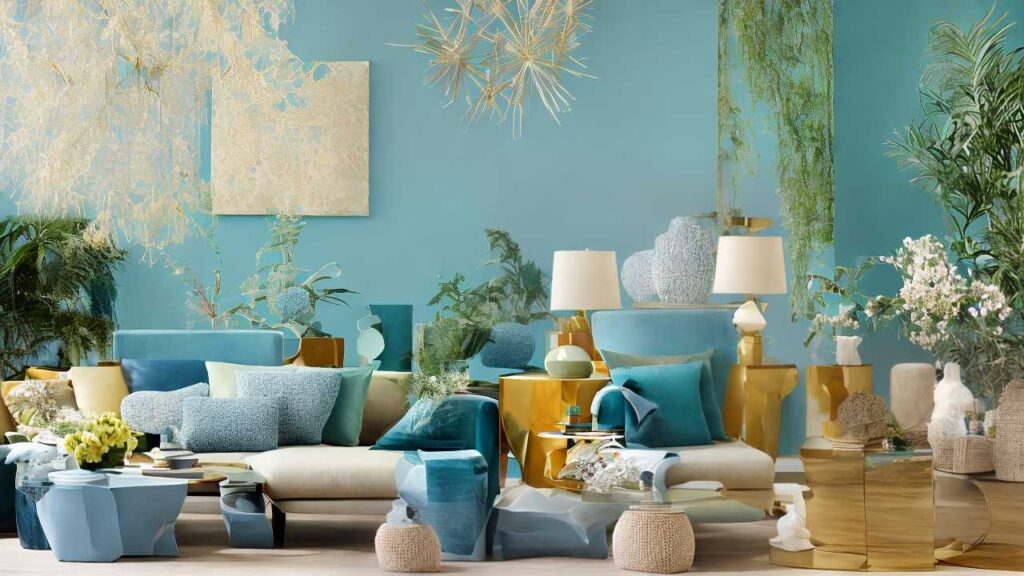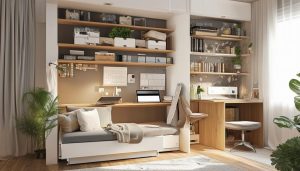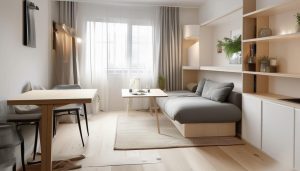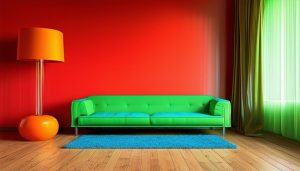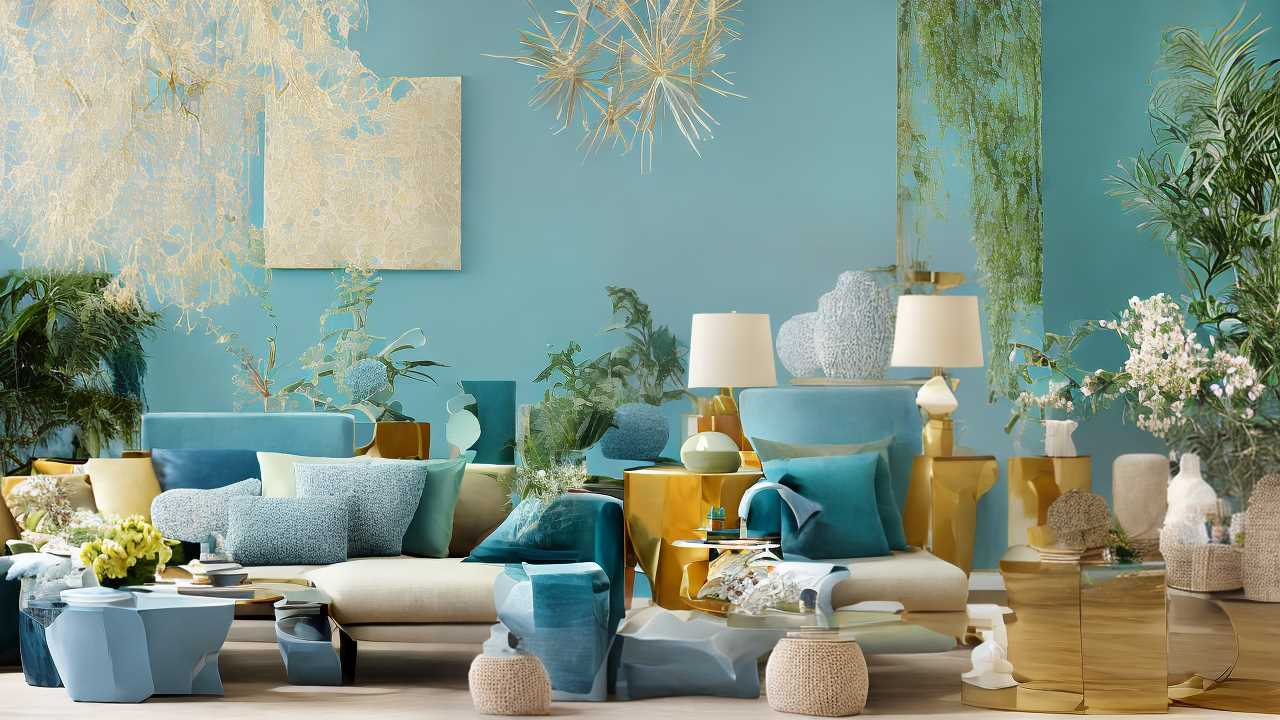
Table of Contents
ToggleColor Palettes: A Fresh Spectrum
Have you ever walked into a room and instantly felt a certain mood wash over you? That’s the power of color at play. The hues we surround ourselves with can invigorate a space, soothe the soul, or create a striking visual statement. As we wave in new decor trends, a fresh spectrum of color palettes takes center stage, offering a transformative experience for any interior.
This year, the trendsetters are favoring colors that bring a sense of calm and clarity. Think serene blues, gentle greens, and soft, earthy tones that echo the natural world. These shades not only create a tranquil backdrop for daily life but also offer a canvas for bolder accents. Imagine a room bathed in cool blue, accented with vibrant pops of mustard or coral, creating a space that’s both peaceful and energetic.
But how do you weave these trending colors into your home without a complete overhaul? It’s simpler than you might think. Start with small yet impactful changes like throw pillows, vases, or wall art in the season’s hottest hues. For the more adventurous, a feature wall in a statement color can redefine your space. And let’s not forget the subtle influence of textiles – curtains, rugs, and linens in trendy shades can shift the ambiance of a room without a single stroke of paint.
Remember, the key to a harmonious color palette is balance. You want your space to feel cohesive, not chaotic. So, whether you’re drawn to the soothing tones of a beachside retreat or the warm embrace of autumnal shades, ensure that your color choices complement each other and your existing decor. Why not let your home tell your story through a palette that’s as unique as you are?
Texture Mixing: A Symphony of Surfaces
Imagine stepping into a room where every surface sings in harmony, each texture playing its part in a symphony of tactile and visual delight. This is the essence of texture mixing, a trend that’s reshaping the way we approach interior design. It’s about creating depth, interest, and an engaging experience that invites touch and closer inspection. But how do you master the art of mixing textures without hitting a discordant note?
The secret lies in balance and contrast. Start with a base texture that sets the tone for the room – perhaps the smooth, cool touch of leather or the warm, grainy feel of wood. From there, layer in contrasting elements. A shaggy rug atop a sleek hardwood floor, glossy metals against matte ceramics, or plush velvet cushions resting on a rough, woven couch – these are the juxtapositions that make a space come alive.
But don’t just think in terms of touch; visual texture plays a role too. Patterns, whether they’re on fabrics, wall coverings, or art pieces, add a dimension of their own. The key is to ensure these patterns complement rather than compete with one another. A striped throw might pair beautifully with a geometric pillow, each enhancing the other’s presence. And let’s not forget the role of light in texture mixing. The way light dances across different surfaces can amplify their impact, creating a dynamic environment that changes throughout the day.
As you curate your textures, ask yourself: does this add warmth, does it invite comfort, does it reflect my style? Your home is your canvas, and with texture mixing, you’re free to create a masterpiece that’s as unique as your fingerprint. So why settle for flat when you can fashion a space that’s brimming with life and personality?
Minimalist Furniture: The Art of Less
In the realm of interior design, minimalist furniture has emerged as a beacon of style for those who seek elegance in simplicity. This design philosophy, which encapsulates the ‘less is more’ ethos, focuses on the essentials to create a serene and uncluttered space. But what is it about minimalist furniture that captivates our hearts and homes?
The allure of minimalist furniture lies in its clean lines and unassuming presence. These pieces are designed to blend seamlessly into the environment, providing functionality without overwhelming the senses. They champion the idea that furniture should not distract but rather complement the living space. A minimalist chair or table, with its sleek form and absence of ornamentation, can stand as a testament to modern craftsmanship and refined taste.
But how can you incorporate minimalist furniture into your home without it feeling too sparse or cold? The answer is in the details. Choosing furniture with warm wood tones or soft textures can add a touch of coziness to the minimalist aesthetic. Pairing these pieces with natural light or soft, ambient lighting can also create an inviting atmosphere that still adheres to minimalist principles. And let’s not forget the role of color – a subdued palette with occasional splashes of bold color can bring vibrancy to a minimalist space without detracting from its overall calm.
Remember, embracing minimalist furniture doesn’t mean you have to sacrifice personality or comfort. It’s about finding the balance between what is necessary and what is superfluous. By selecting pieces that truly resonate with your personal style and meet your functional needs, you can create a home that is both modern and timeless. Isn’t there something truly liberating about stripping back the excess and surrounding yourself with only what you love and need?
Statement Lighting: Illuminating with Style
Lighting is not just a practical necessity; it’s a style statement that can elevate the ambiance of any room. Statement lighting fixtures act as the jewelry of your space, drawing the eye and adding a touch of elegance or drama. But how do you select a piece that stands out while harmoniously blending with your decor?
When choosing statement lighting, consider the fixture’s design as much as its function. Do you lean towards the bold and sculptural, or the sleek and understated? A chandelier with intricate metalwork can become a focal point in a minimalist room, while a series of simple pendant lights may add a rhythmic aesthetic to a more ornate space. The material and finish of your lighting can also play a significant role in the overall effect—brass can introduce warmth, glass can add a touch of sophistication, and colored fixtures can inject personality.
But it’s not just about how these fixtures look in the daylight. Think about the quality of light they emit. Do they cast a wide, welcoming glow or a targeted beam that highlights a specific area? The right lighting can change the mood of a room, making it cozy and intimate or bright and energetic. And with the advent of LED technology, you can enjoy statement lighting that’s not only stylish but also energy-efficient and long-lasting.
Remember, statement lighting is about making a bold choice that reflects your taste and complements your living space. Whether it’s a mid-century modern floor lamp beside a reading chair or an avant-garde installation above your dining table, these pieces are conversation starters that show off your design savvy. So why not let your lighting shine a spotlight on your impeccable style?
Biophilic Design: Nature’s Embrace
Biophilic design is more than just a trend; it’s a return to our roots, reconnecting us with the natural world from which we often feel detached. This design philosophy integrates elements of nature into our living spaces, promoting health, well-being, and a sense of peace. But what does it truly mean to embrace biophilic design in your home?
At its core, biophilic design is about creating a dialogue between your indoor environment and the outdoors. It’s about incorporating natural materials, such as wood, stone, and bamboo, that evoke the textures and colors of nature. Large windows that offer views of greenery or water, indoor plants, and water features can all enhance this connection, blurring the lines between inside and outside. The presence of nature in our homes can reduce stress, enhance creativity, and improve our overall mood.
But biophilic design isn’t just about adding a potted plant here or a wooden table there. It’s about understanding the rhythms of nature and reflecting them in our living spaces. Natural light plays a pivotal role, with spaces designed to maximize daylight and mimic the changing light patterns throughout the day. Even the use of nature-inspired patterns and artwork can contribute to a biophilic environment, creating a subconscious bond with the natural world.
As we spend more time indoors, the importance of incorporating elements of nature into our homes becomes ever more apparent. Biophilic design offers us a way to sustain that intrinsic connection to the natural world, enriching our lives and rejuvenating our spirits. So why not invite nature into your home and let it work its magic?
Sustainable Materials: Eco-Friendly Choices
As awareness of environmental impact grows, sustainable materials are becoming a cornerstone of home decor. These eco-friendly choices are not just good for the planet; they bring a sense of earthy authenticity and responsible luxury to our living spaces. But what exactly makes a material sustainable, and how can you incorporate these elements into your home?
Sustainable materials are characterized by their low environmental footprint. They are often sourced from renewable resources, manufactured with minimal pollution, and are recyclable or biodegradable at the end of their life. Bamboo, cork, and reclaimed wood are prime examples, offering durability and a unique aesthetic while also being kind to the earth. These materials can be used in everything from flooring to furniture, and even in decorative accents throughout the home.
But choosing sustainable materials isn’t just about selecting the right products; it’s also about embracing a philosophy of mindful consumption. It involves asking questions about the origins of the materials, the ethics of their production, and the longevity of the items you bring into your home. By opting for pieces that are not only beautiful but also built to last, you’re making a statement about the value you place on sustainability.
Incorporating sustainable materials into your decor doesn’t mean sacrificing style or comfort. On the contrary, it offers an opportunity to create a home that is both stylish and sustainable. With a growing number of designers and brands focusing on eco-friendly products, finding pieces that reflect your personal taste has never been easier. So why not make a choice that feels good for both your home and the environment?
Smart Home Integration: The Connected Abode
The modern home is no longer just a place to rest your head; it’s a connected hub that integrates technology into everyday life. Smart home integration is at the forefront of this transformation, offering homeowners convenience, security, and energy efficiency at the touch of a button. But what does it take to transform your living space into a smart home, and what are the benefits?
Smart home technology encompasses a wide range of devices and systems that can be controlled remotely or through automation. From smart thermostats that learn your temperature preferences to lighting systems that adjust based on the time of day, the possibilities are endless. Voice-activated assistants can manage your entertainment systems, while smart locks and security cameras provide peace of mind with real-time monitoring and alerts.
Integrating these technologies into your home is simpler than you might think. Many smart devices are designed for plug-and-play installation, and with the help of user-friendly apps, you can control your home’s functions from anywhere. The key is to start with what matters most to you, whether that’s cutting down on energy bills, enhancing home security, or simply making your daily routine a little easier.
But smart home integration isn’t just about convenience; it’s a lifestyle change that can contribute to a more sustainable future. By optimizing energy usage and reducing waste, smart homes play a part in conserving our planet’s resources. So why not join the growing number of homeowners who are making the switch to a smarter, more connected way of living?
Vintage Accents: Timeless Elegance
There’s something about vintage accents that can infuse a space with character and soul, creating a narrative that’s as rich as the pieces themselves. This timeless elegance is coveted by many, as it brings a sense of history and uniqueness to our modern homes. But how do you incorporate vintage accents without your space feeling like a time capsule?
The key to integrating vintage elements is to blend them with contemporary decor, striking a balance that feels both fresh and classic. A vintage lamp atop a modern console, an antique mirror against a clean-lined wall, or a set of vintage chairs around a sleek dining table can create a dialogue between the old and the new. It’s this juxtaposition that allows vintage pieces to stand out, adding depth and visual interest to your home.
Finding the right vintage accent can be an adventure in itself. Whether it’s scouring flea markets, visiting antique shops, or inheriting family heirlooms, each piece tells a story. And when you find that perfect item, it’s not just about the aesthetic appeal; it’s about the life it has lived and the stories it carries. These pieces don’t just decorate a room; they animate it.
Embracing vintage accents is also a sustainable choice. By giving new life to old items, you’re participating in a cycle of reuse that’s beneficial for the environment. So, as you curate your collection of vintage treasures, remember that you’re not just decorating your home; you’re preserving a piece of the past and making it a part of your future. Isn’t there something truly magical about that?
Open-Plan Layouts: Spacious and Social
Open-plan layouts have revolutionized the way we think about our living spaces, championing a spacious and social approach to interior design. By breaking down walls, these layouts create multifunctional areas that breathe life into the home, fostering a sense of togetherness and fluidity. But what is it about open-plan living that resonates so deeply with contemporary homeowners?
The beauty of an open-plan layout lies in its versatility. It allows light to cascade through the space, making it appear larger and more inviting. The absence of barriers between the kitchen, dining, and living areas encourages interaction and communal living, whether you’re hosting a dinner party or simply enjoying family time. This seamless flow also provides a blank canvas for your decor, enabling you to create distinct zones without the need for physical partitions.
But how do you ensure your open-plan space doesn’t lose its sense of warmth and intimacy? The answer is strategic design. Rugs can anchor different areas, while lighting can be used to delineate spaces and create ambiance. Furniture placement is crucial; a well-positioned sofa or bookshelf can subtly divide the space without disrupting the open feel. And let’s not forget the power of color and texture to add depth and interest to the room.
Embracing an open-plan layout is about more than just following a trend; it’s about crafting a living space that reflects a modern, relaxed lifestyle. It’s about creating an environment where cooking, dining, and relaxing all take place in a shared, harmonious space. So why not open up your home and see how an open-plan layout can bring a new sense of freedom and connection to your daily life?
Multifunctional Spaces: Adaptable Living
In today’s dynamic world, the concept of multifunctional spaces has become an integral part of home design. These adaptable living areas cater to the diverse needs of modern life, combining work, leisure, and relaxation all in one harmonious environment. But how do you create a space that can effortlessly transition between different functions while maintaining a cohesive look?
The key to designing a multifunctional space is flexibility. Furniture that serves multiple purposes, such as a sofa bed or an extendable dining table, can transform a room to suit your current need. Storage solutions are also vital; cleverly designed units can hide away office supplies or children’s toys, ensuring that the space can quickly adapt to its next use. The use of movable partitions or curtains can offer privacy for a home office setup or a guest sleeping area without the need for permanent structural changes.
But it’s not just about practicality; aesthetics play a crucial role in making multifunctional spaces work. The choice of a consistent color palette and harmonious materials can tie the room together, making the transition between uses feel natural. Thoughtful lighting can set the mood for work or relaxation, and accessories can be curated to add personality without clutter.
Embracing multifunctional spaces reflects a lifestyle that values adaptability and smart use of space. Whether you’re in a cozy studio apartment or a spacious family home, the ability to customize your living area to fit your changing needs is a testament to thoughtful, modern living. So why not rethink your space and discover the endless possibilities of adaptable living?
Artisanal Touches: The Handcrafted Appeal
In a world where mass production dominates, the allure of artisanal touches in home decor stands out, offering a connection to the hands and hearts of skilled craftspeople. These handcrafted accents bring with them an appeal that is both personal and profound, but what is it about these pieces that captivates and charms homeowners and designers alike?
Artisanal touches come in many forms, from hand-thrown pottery to woven textiles, each with its own story and heritage. These pieces are more than just objects; they are the embodiment of tradition, craftsmanship, and the human touch. The slight variations and imperfections in these items are not flaws but rather marks of authenticity, setting them apart from their machine-made counterparts. They add texture, warmth, and a sense of uniqueness to a space that can’t be replicated by something off the shelf.
Integrating artisanal elements into your home decor is an art in itself. It’s about finding that perfect handcrafted vase or bespoke wooden stool that resonates with your style and complements your space. It’s about mixing the old with the new, the polished with the imperfect, to create a layered and lived-in look. And let’s not forget the impact of supporting artisans and their communities, preserving age-old techniques and fostering sustainable practices.
So, why not invite the beauty of handcrafted goods into your home? Whether it’s a handwoven basket, a ceramic dish, or a custom piece of furniture, these artisanal touches can transform your space, making it feel more grounded and connected. Isn’t it time to celebrate the unique and the handcrafted, and to create a home that’s as individual as you are?
Personalized Art: Expressing Individuality
In the tapestry of home decor, personalized art is the thread that weaves individuality into the overall design. It’s a reflection of personal taste, experiences, and the stories that make us who we are. But what is it about personalized art that makes it such a pivotal element in expressing one’s individuality within their living space?
Personalized art can take many forms, from a custom-painted mural to a framed collage of cherished memories. These pieces serve as a visual autobiography, showcasing the colors, textures, and subjects that resonate with us on a deeper level. They can be conversation starters, mood enhancers, or simply a source of joy. The beauty of personalized art lies in its ability to encapsulate moments and emotions, transforming them into tangible pieces that adorn our walls and shelves.
Incorporating personalized art into your decor isn’t just about hanging a picture; it’s about creating a space that truly feels like an extension of yourself. It’s choosing artwork that speaks to you, whether it’s a bold abstract painting that captures your adventurous spirit or a serene landscape that offers a sense of calm. And with the rise of custom art services and platforms, obtaining a piece that’s tailor-made for you has never been more accessible.
Why settle for generic when you can surround yourself with art that tells your story? Personalized art is an investment in your happiness and the aesthetic of your home. It’s a way to ensure that your space is not just stylish, but also deeply personal. So go ahead, let your walls speak and let your art reflect the unique individual you are.
As we navigate through the myriad of home decor trends, it’s clear that the heart of a well-designed home lies in its ability to adapt to our personal tastes and functional needs. From the vibrant hues of the latest color palettes to the rustic charm of vintage accents, each element plays a crucial role in creating a space that is both stylish and comfortable. Smart home integration and sustainable materials reflect our growing consciousness for convenience and environmental responsibility, while minimalist furniture and multifunctional spaces echo our desire for simplicity and versatility. By embracing these trends and making them our own, we craft living spaces that are not just reflections of the times but are timeless in their appeal. Let your home be a canvas for your individuality, a space where every corner tells a story, and every piece resonates with your personal journey.
How can I incorporate texture mixing into my home without it feeling cluttered?
To avoid a cluttered look, focus on balancing textures and ensure they complement each other. Use a neutral base for your decor and add textured accents strategically to maintain a cohesive aesthetic.
What are some key elements of biophilic design?
Key elements of biophilic design include natural light, incorporating plants and water features, using natural materials, and creating visual connections with nature.
Can smart home features be integrated into any style of decor?
Yes, smart home features can be seamlessly integrated into any decor style. Many smart devices come in various designs to match your home’s aesthetic, and some can be concealed within fixtures or furniture.
What should I consider when selecting sustainable materials for my home?
When selecting sustainable materials, consider their environmental impact, durability, and whether they are renewable or recyclable. Also, think about how they will fit with the existing style and function of your space.
How do I choose the right statement lighting for my space?
Choose statement lighting that complements the scale of your space and reflects your personal style. Consider the fixture’s design, the quality of light it emits, and how it interacts with other design elements in the room.

